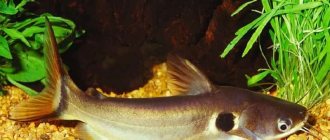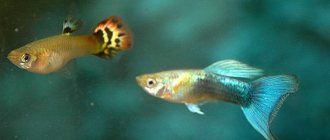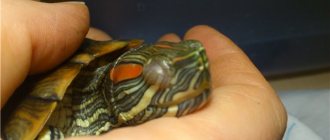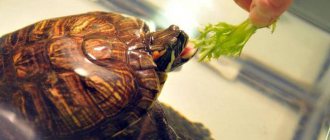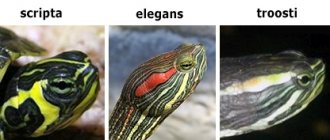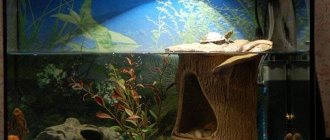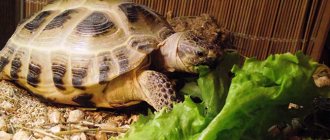The eyes are a fairly serious organ of turtles, which have minimal protection from the influence of harmful bacteria living in the water. Eye diseases can cause discomfort, but sometimes lead to blindness. In this regard, it is necessary to constantly monitor the condition of the turtle’s eyes and at the first symptoms, the simplest measures should be taken to improve the condition of the eyes. If this does not give any effect, then you should immediately contact your veterinarian.
Eye diseases of red-eared turtles and their symptoms
The following symptoms may indicate eye disease in a turtle:
- Redness of the mucous membrane of the eyes.
- Swollen eyelids.
- The appearance of a white coating on the eyeballs.
- The turtle is unable to open his eyes.
- Cloudiness of the cornea.
- Slow reaction of the eyeball to current events.
The above symptoms may be accompanied by general weakness, poor appetite, high fever, and impaired coordination of movements.
Such symptoms indicate the presence of an eye disease such as conjunctivitis. It is caused by bacteria staphylococci and streptococci.
This serious illness can be caused by poor diet or unsanitary conditions. If the water in the aquarium has not been changed for a long time, then the red-eared slider’s eyes will first of all become swollen, which will indicate that the water is polluted.
Another serious turtle eye disease is panophthalmitis. This disease is caused by a purulent infection that affects the tissue of the eyeball. Evidence of such a disease can be clouding of the eyeball, and if appropriate treatment is not started immediately, the turtle may lose its vision.
Disease Prevention
Diseases of red-eared turtles often lead to sad consequences, so the best way to cure your pet is to prevent the development of diseases. To avoid problems, you need to follow the recommendations of experienced owners:
- The terrarium is constantly cleaned and water replaced.
- Turtles are provided with a balanced diet containing vitamins and calcium. It is important to know what you can feed your red-eared slider.
- Before serving vegetables and herbs, the products are processed.
- The terrarium is provided with good lighting, which is necessary for turtles, and ventilation.
- Before new neighbors or decorations are placed, they are checked for diseases and bacteria.
- The required water temperature is maintained in the terrarium.
Red-eared turtles are cute and funny pets that, if properly maintained, can delight their owners for decades. To avoid the development of dangerous diseases, you should carefully care for the animal, following the rules for caring for a red-eared turtle and the recommendations of qualified specialists.
Treatment of eye diseases of the red-eared turtle
At the first appearance of symptoms, the animal should be immediately placed in clean water, since it is contaminated water that leads to eye diseases. Since the causative agents are infections, antibiotics and drops are used for treatment.
For medicinal treatment it is possible to use the following pharmaceutical products:
- These can be “Sofradex”, “Tseirolet”, “Albucid”, “Topradex”, which are instilled into the eyes twice a day. If the turtle is unable to open its eyes, then carefully pull back the lower eyelid and apply eye drops. The course of treatment can last from 5 to 10 days, depending on the degree of damage.
- A disease such as panophthalmitis can only be treated with antibiotics and only under the supervision of a veterinarian. Self-treatment is not advisable, as it can lead to the death of the animal.
- If the disease is advanced, there is a high probability that the eyeball will be removed.
- In the process of treating turtle eye disease, it is advisable to enhance the effect by using multivitamins, such as “Intravit”, “Multivit”, “Eleovit”. Since vitamin D2 is poisonous for turtles, you should always pay attention to the content of the corresponding vitamins in the preparations. At the same time, vitamins can be administered by injection, if, of course, the doctor does not mind.
- To alleviate the suffering of the red-eared turtle, it is possible to use chamomile decoction and a solution of boric acid. They moisten swabs and remove plaque from the turtle's eyes.
- At the very beginning of the appearance of signs of the disease, tetracycline ointment can help.
How to recognize otitis?
The sooner this disease is detected, the easier and simpler it can be dealt with. Therefore, you should not forget about your pets. If the turtle is regularly examined, the onset of the disease can be detected in the form of a small swelling in the area of the ears. The size of the tumor may vary. A tumor several centimeters in size indicates that the disease is progressing. In very severe cases, asymmetry of the head is observed.
The disease can be detected by carefully studying its behavior at the moment. A turtle can express anxiety by scratching its paw in the area of its ears. Sometimes the turtle may lose coordination, falling over on its side. If you notice changes in your pet's behavior, you need to conduct a careful examination or immediately contact a veterinarian.
As a rule, individuals who have reached the age of 10-15 years suffer from this disease. Experts associate this with weakened immunity.
Nutrition of red-eared turtles for eye disease
In case of eye damage, it is very important to provide the turtle with proper nutrition. A turtle's diet should include foods rich in vitamin A. As far as we know, vitamin A is good for vision, and not just for turtles. Carrots are rich in this vitamin. The basis of the turtle's food is seafood, but if there is an eye disease, you can give it livers once a week, and also focus on food of plant origin, such as cabbage, seaweed, lettuce, and seaweed. As a rule, such foods are rich in vitamins.
If your pet is seriously ill and cannot open its eyes, it will be difficult for him to find food in the aquarium. In this case, the owner himself will need to feed the animal, otherwise it may die of starvation.
If there are other animals near the sick turtle, then it is better to isolate the sick turtle so that the disease does not harm its relatives.
Signs of conjunctivitis
However, not all novice owners of these reptiles are able to quickly and accurately create the necessary conditions for them. You can identify conjunctivitis yourself, or you can treat it without the help of a veterinarian. Symptoms of this disease are:
- Formation of pus in the eye area;
- The turtle does not open its eyes for a long time. To identify this symptom, you need to make sure that the animal is not sleeping;
- Eye tumor;
- The eyes may also become watery.
Video
More photos Author(s):
E. Sekushina, DVM, St. Petersburg
Magazine:
No. 1-2 - 2012
Key words: red-eared turtle, turtle pneumonia
Introduction
Currently, pet lovers keep in their apartments not only the usual cats, dogs, parrots and hamsters, but also various exotic ones. Various reptiles have been especially popular in recent years - snakes, lizards, crocodiles, turtles and many others, which attract with their unusualness.
Of all the species of aquatic turtles, red-eared turtles are the most sought after as pets. The first mention in history of red-eared turtles is found in the books of the Spanish colonialists who captured Peru.
The homeland of red-eared turtles is Central America, mainly Mexico, as well as the southern states of the United States and northern South America. But in recent years, thanks to their ability to tolerate lower ambient temperatures, they have acclimatized well. Turtles are quite common and are found in regions outside their natural habitat in Central and Southern Europe, Israel, Australia, Japan, and Southeast Asia.
In nature, red-eared turtles are quite healthy, but at home they need constant attention and good care, as they live outside their natural habitat.
The most common disease of the respiratory system of red-eared turtles is pneumonia. Pneumonia is quite common in domestic reptiles, including turtles. Red-eared turtles at home suffer most from drafts, insufficient ventilation of terrariums and low water temperatures. All these stress factors lead to the development of respiratory diseases.
Etiology
Pneumonia is a multi-etiological disease that poses a potential threat to life. Pneumonia is caused by various bacteria that are activated in the body of animals during sudden changes in climatic conditions, drafts, hypothermia, i.e., non-compliance with the conditions for keeping turtles plays a significant role in the development of pneumonia. Turtles can get hypothermia from the fact that the aquarium is in a draft or on a window under an open window, when there is a sharp change in temperature when the water in the aquarium is changed. Proper feeding also plays an important role. A lack of vitamins A (carotene) and D (calciferol) leads to disruption of the structure of the mucous membranes and reduces their protective function.
Stage I pneumonia. “Wet” or “exudative” pneumonia occurs suddenly and is acute. It is usually caused by short-term keeping of turtles at low temperatures, without food and in crowded conditions, i.e., during transportation, overexposure, trading in a cold room, on the street or market, etc. The disease can appear within 3-4 days and, in some cases, leads to death within a few days, or even hours.
Pneumonia stage II. “Dry” or “purulent” pneumonia develops when stage I pneumonia stabilizes or occurs as an independent process. Prolonged or sudden cooling combined with dehydration.
Mycotic pneumonia (systemic mycoses). Specific mycotic pneumonia in turtles is quite rare.
This form of pneumonia is typical for immunosuppressed animals kept in unsuitable conditions. The “risk group” usually includes desert species of tortoises, which are kept at high humidity and on soil contaminated with light organic material that produces dust (sawdust, peat, feed such as alfalfa pellets, etc.); animals that have been treated with antibiotics for a long time, vitamin deficiency.
Most often, mycosis of the lungs complicates primary bacterial pneumonia, especially with long courses of antibiotic therapy. Swamp turtles kept with ornamental fish can be infected by them. The diagnosis is difficult to make based on clinical signs.
Mycotic pneumonia can be assumed if antibacterial therapy does not have an effect, and this species of turtle is included in the “risk group”. Water and land turtles are equally susceptible to this disease. In this case, prevention plays a big role. Treatment is ineffective, but you still need to contact a veterinarian.
Clinical signs
Pneumonia can proceed covertly for a long time, until the compensatory capabilities of the turtle’s body are exhausted. Such animals exhibit respiratory syndrome, requiring immediate therapeutic correction. The most striking sign of pneumonia in turtles is shortness of breath, usually inspiratory, less often mixed (inspiratory and expiratory). The cough reflex is not a typical sign, since the lack of movement of the cilia of the pulmonary epithelium, the lack of expression of the cough reflex and the thickness of the forming exudate in turtles do not contribute to the development of an ascending infection. Respiratory movements are rapid, enhanced by body movements; the mouth is open, whistling sounds, wheezing when breathing, mucus in the oral cavity, stretching in threads, may be heard. Then a runny nose may appear, in which the fluid released from the nostrils forms bubbles, and difficulty breathing. The turtle becomes lethargic, tries to spend less time in the water, most often climbs onto land and hides in its shell, eats poorly, and does not respond to irritations. A sick animal floats on the surface and does not sink, dives poorly, while swimming it opens its mouth and breathes convulsively, one side, on the side where the source of the disease is located, is raised up. When the turtle breathes, gurgling wheezes are heard, while exhaling, white flakes appear in the water, and the mucus in the mouth becomes yellowish and cloudy. Further progression of the disease leads to depletion of the immune system and the development of complications. Swelling of the eyelids may appear, a white film may form on the eyes, brownish-brown spots appear on the skin, which spread from the tip of the nose to the head and neck.
When assessing the severity of pneumonia in turtles, the veterinary herpetologist also considers the level of respiratory distress, mental status (whether the turtle is conscious or depressed and lethargic), and degree of dehydration.
X-rays help confirm the diagnosis, assess the severity of the disease and the dynamics of treatment. The most informative image in turtles is considered to be in the craniocaudal projection. Normal lung tissue has a fine mesh pattern. Increased density of one or both lungs suggests the presence of pneumonia. Changes can be diffuse or focal. More advanced technologies (CT, MRI) make it possible to accurately assess the number and size of pneumonia foci in the lungs of turtles.
Treatment. Since most turtles present with advanced stages of pneumonia, treatment must be quite aggressive.
Antibiotic therapy. Ideally, antibacterial therapy should be carried out in accordance with the results of antibiotic sensitivity; however, the serious condition of the animal usually does not allow waiting for the results of a bacteriological study.
The issue of choosing antimicrobial drugs and the method of their use in the treatment of reptiles is quite acute in our country and abroad. The peculiarities of the use of antimicrobial drugs are due to a number of anatomical and physiological differences, as well as differences in the microflora of reptiles and mammals. It is also important that there are a limited number of antibiotics used in chemotherapy for reptiles. The use of penicillin and tetracycline antibiotics can have a negative effect on the body of turtles and lead to the death of reptiles.
Features of the microflora are that the vast majority of gram-positive microorganisms for reptiles are conditionally pathogenic or are normal microflora. Pathogenic are coagulase-positive staphylococci and streptococci with bethemolysis. Among gram-negatives there are also peculiarities. For example, Salmonella is a normal microflora; only some strains are conditionally pathogenic for reptiles, while being pathogenic for mammals. Most pathogenic microorganisms of reptiles are resistant to many modern antibiotics, and are sometimes sensitive to traditional drugs.
Bacterial pneumonia in turtles is most often caused by gram-negative organisms, therefore, for their treatment, some authors recommend using combinations of aminoglycosides and beta-lactam antibiotics.
Taking into account the listed and other characteristics of reptiles, it is advisable to prescribe the following antimicrobial drugs: 1) fluoroquinolones: enrofloxacin and ciprofloxacin; 2) aminoglycosides: gentamicin, amikacin, kanamycin, streptomycin, neomycin; 3) chloramphenicol (chloramphenicol); 4) III generation cephalosporins: ceftazidine, cefolerazine;
In cases where anaerobic microflora is suspected, metronidazole is used.
Most often, intramuscular injections are given to treat pneumonia. There is no need to wipe the turtle’s skin with anything before the injection if the turtle itself is clean. Can be washed with running water. Alcohol causes burns to reptiles!
Before removing the needle from the animal’s body, lightly press the skin with a clean finger near it, this will reduce the pain. Then the place where the medicine was injected is lightly massaged for about a minute - so that the liquid is better distributed in the adjacent tissues and absorbed faster.
Antibiotics are administered intramuscularly (only in the front paws) using a 1 ml or 0.5 ml syringe with a 27G needle.
Injections can be given in three areas: in the shoulder muscle (front legs), in the thigh muscle (hind legs) or in the gluteal region (left or right of the tail). It is necessary to prick between the scutes.
Before directly injecting the medicine into the muscles, it is necessary to pull the syringe plunger towards you to make sure that the needle is not in the vessel. If it is in it, blood will appear in the syringe. In this case, the needle is moved a little deeper.
Injections into the shoulder muscle are made into the shoulder of the outstretched front paw, the needle should go parallel to the shoulder bone. Injections into the thigh muscle are made into the thigh of the extended hind leg, and the needle should go parallel to the thigh bone in the gluteal region; the injection is made closer to the carapace between the tail and the hind leg. It is necessary to prick between the scutes.
Symptoms may disappear after the first injection of antibiotic (usually within a few hours). The main drug is baytril (2.5% baytril, at a dose of 0.4 ml/kg every other day in the shoulder muscle) or amikacin (2.5 mg/kg every 72 hours). Reserve group drugs - oxytetracycline, ceftazidime (20 mg/kg every 72 hours), ampiox sodium in doses of 200 mg/kg intramuscularly, chloramphenicol-succinate. If therapy does not cause obvious improvement within 3-4 days, it is better to prescribe aminoglycosides. During treatment, the turtle must be kept at daytime temperatures of at least 30-32°C.
A sick turtle usually refuses food; subsequently, the turtle becomes inactive, quickly loses weight and becomes dehydrated.
A 5% glucose solution or Ringer-Lock solution 10-20 ml/kg, IV, every 12 hours, which is administered intracoelomically, is prescribed as a nutrient solution.
To administer large amounts of liquids (Ringer-Locke solution, for example), the turtle is fixed upside down, while the internal organs are displaced under their weight from the injection site. The drug is injected into the cavity in the inguinal fossa above the plastron, in front of the base of the hind paw. The skin and underlying muscles are pierced with a needle, the direction of movement of the needle is diagonal to the front paw on the opposite side.
When the needle is positioned correctly, blood, urine, and intestinal contents should not be sucked into the syringe.
In advanced forms of pneumonia, when swelling of the eyelids and dermatitis appear, a course of vitamin therapy is prescribed. When choosing vitamins, you need to take into account that turtles have a species intolerance to the drugs Gammavit, Aminovit, Aevit. It contains vitamin D2 calciferol (ergocalficerol, calciferol). It is toxic and dangerous for turtles.
From the group of calciferols, vitamin D3 (cholecalciferol) is harmless to turtles. It is contained in Eleovit, Multivit, Introvit, etc. Eleovit is prescribed 0.6 (aq.) 0.8 (dry.) ml/kg every 2 weeks x 2. The drug is injected under the skin at the base of the shoulder or thigh with the medial his sides.
If the limb can be extended, then they prick into the middle of the skin covering the inguinal notch of the shell or under the skin at the base of the thigh. If it is difficult to extend the limb, then they prick by inserting a needle along the edge of the lower shell, under the retracted limb and shallowly. Spearing severely dehydrated turtles can be dangerous because... in the area of the inguinal fossa, the wall of the bladder may be intimately connected with the subcutaneous aponeurosis.
Phytotherapy. Additionally, warm baths with chamomile infusion are given to sick turtles. Two tablespoons of chamomile are poured with hot water, but not boiling water, for 20-30 minutes, then the broth is filtered and diluted with water in a ratio of 1:3. The turtle is placed in this solution and remains there for 30 minutes to an hour. After this, we place the red-eared turtle home, having previously raised the water temperature in the aquaterrarium to 28-29 degrees. Chamomile decoction can be added to the aquarium. Turtles can swim in it until you change the water for them. If necessary, you can bathe the turtles in the broth every other day until they recover.
Doses of medicinal substances for turtles are given in (Table 1)
. You need to be careful and know which medications are toxic to turtles: Abomectin, Aversectin S (Univerm), Vermitox, Vishnevsky ointment, Gamavit, Dekaris, Ivermectin (Ivomec, macrocyclic lactones), Combantrin, Levamisole (Dekaris, Tramizol), Metronidazole (Trichopol, Flagyl) 100-400 mg/kg (toxic dose), Moxidectin (Cydectin), Omnisol, Piperazine adipate (Vermitox), Pyrantelembonate (Embovin, Com-bantrin), Ripercol, Tetramizole (Ripercol), Thiabendazole (Omnisol), Tramisol, Trivit, Cydectin, Embovin, Univerm.
Prevention. In nature, red-eared turtles are fairly healthy, but at home they need constant attention and good care, as they live outside their natural habitat and can get sick. Unfortunately, it is not always possible to avoid this, but many diseases can still be prevented by taking simple preventive measures.
The turtle must be kept warm and protected from drafts. It should be remembered that most often the occurrence of these diseases is caused by a violation of the temperature regime.
The water temperature in the aquarium is from 25 to 30°C, the air temperature in the room is about 30°C. The water in the pool should be changed as it gets dirty 1-2 times a week. It is better to use a powerful filter (internal for young turtles, external for adult turtles).
Above the island you need to install an incandescent lamp of 40-60 W and an ultraviolet lamp for reptiles (with 5% UVB / or Repti-Glo 10.0) at a height of at least 20-25 cm. Turtles usually bask on land, where they receive the ultraviolet radiation necessary for activity and prevention of rickets.
In the warm season, it is advisable to take turtles outside in the sun as often as possible (at outside temperatures of more than 20°C). The first exposure to the sun is limited to five minutes, gradually the duration of sunbathing is increased to two hours or more. Since turtles overheat quickly, it is necessary to create a shaded area where the animals can escape if necessary.
In many ways, the health of a turtle depends on the minerals and vitamins it receives with its food. The lack of necessary elements leads to various developmental disorders, diseases and even death of turtles. The foods that a domestic turtle eats do not always contain all the necessary substances, so it is recommended to add special vitamins to its food to prevent health problems, because it is always easier to prevent a disease than to treat it.
Literature
1. Bashinsky V.V. Turtles. Features of maintenance and treatment Publishing house AST 2005
2. Gurzhiy A.N. Aquarium and land turtles. Publishing house Delta-M, p. 144, 2002
3. Gurzhiy A.N. Pond slider. Content. Feeding. Breeding. Treatment Publisher: Aquarium-Print, p. 48, 2011
4. Krasichkova A. - Red-eared turtles.
5. https://cherepahi.ru/ - Website about turtles.
Back to section
